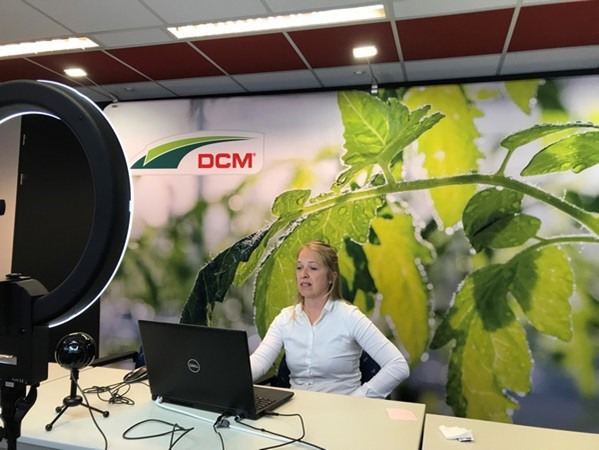First aid with ToBRFV was the title of last week’s webinar organized by DCM for tomato growers from Belgium and the Netherlands. A variety of specialists were given time to speak.
 Moderator Thijs De Langhe introduced Christine Vos of Scientia Terrae as the first speaker. Christine gave a brief review of the rapid spread of this annoying tomato virus. In 2014, the first outbreak took place in Israel. In 2018, Europe and Mexico were the unfortunate targets. Currently, there are 3 registered cases in Belgium and 23 in the Netherlands.
Moderator Thijs De Langhe introduced Christine Vos of Scientia Terrae as the first speaker. Christine gave a brief review of the rapid spread of this annoying tomato virus. In 2014, the first outbreak took place in Israel. In 2018, Europe and Mexico were the unfortunate targets. Currently, there are 3 registered cases in Belgium and 23 in the Netherlands.
Trained eye
There are multiple symptoms of ToBRFV. The symptoms appear to depend on the variety that is being cultivated, the temperature, the climate, and the isolate. Unfortunately, the virus thrives in high temperatures and appears to be spreading rapidly in greenhouses during warm and sunny weather conditions. Due to the many symptoms, the disease is difficult to recognize, and getting the full picture can be confusing. A trained eye is needed to look for signs of the disease. Christine: “When in doubt, try to get advice from a lab. Only analytical results can provide a definitive answer.”
Many different tests are now available. These can, for instance, detect a protein coating on the genetic material (RNA). The methods vary in sensitivity, precision, lead time, and price. Christine advises inquiring about these parameters when going to a lab for help. During a ToBRFV Detection Ring Test conducted with various labs in Europe, one of which was Scientia Terrae, it turned out that the quantitative PCR tests for ToBRFV were 1000 to 100,000 times more sensitive than regular PCR tests. The ELISA test has a similar sensitivity to the regular PCR.
No symptoms, but still a virus
Seeds, plants, and fruits can all contain the virus. What makes it even more difficult is the fact that contaminated parts with a high concentration of the virus don’t necessarily show any symptoms. The virus is very stable and remains infectious for a long time. The virus is transferred mechanically, mainly through humans, materials, and contaminated surfaces, but can also be transferred through a secondary source such as bumblebees and contaminated water. Be sure to keep these (potential) sources of infection in mind when writing hygiene protocols.
In collaboration with LAVA and the Belgian test centers, Scientia Terrae has tested disinfectants on plant saps in watery environments, hard plastics, and steel. They also tested hand hygiene, for which disposable gloves are still the best method by far.
Intermezzo: DCM products in tomato cultivation  Laura Pelleriaux is a technical advisor biorationals at DCM in Belgium. During the intermezzo, she quickly touched upon the products DCM recommends in tomato cultivation. In chronological order, Laura she advised the following products: vaccination with PMV-01 to protect against PepMV when the plants arrive in the greenhouse. Next, three biostimulants): InterAct (upon first bloom for generative control), Vitact F (upon planting in the ground for good root development in the mat) and Impuls TD (for a vitality boost in stressful periods). Each product was illustrated by Laura with a practical example.
Laura Pelleriaux is a technical advisor biorationals at DCM in Belgium. During the intermezzo, she quickly touched upon the products DCM recommends in tomato cultivation. In chronological order, Laura she advised the following products: vaccination with PMV-01 to protect against PepMV when the plants arrive in the greenhouse. Next, three biostimulants): InterAct (upon first bloom for generative control), Vitact F (upon planting in the ground for good root development in the mat) and Impuls TD (for a vitality boost in stressful periods). Each product was illustrated by Laura with a practical example.

Annelies during the webinar
Look for and recognize
Annelies Justé mainly talked about practical tools to use in cases of ToBRFV. Looking for the problem is very important, but recognizing it is not an easy task. The symptoms of ToBRFV are often confused with those of the Pepino mosaic virus. “Take samples,” she warns. “And put on a fresh pair of gloves for each sample you take.”
Annelies also emphasizes the importance of vaccinating with PMV-01 in times of ToBRFV, explaining the statement with practical examples and scientific literature.
The good news
Recently, ToBRFV-resistant genes have been discovered. A publication came out describing 28 IR genotypes, among which commercial varieties and 1 HR genotype. This is great news and promising development for tomato growers.
Annelies also spoke about the long-term research into solutions against the virus, which DCM is working on so they can act quickly in case new viruses or pathogens were to appear in the future.
Finally, Annelies amplified on the large-scale European project regarding ToBRFV with 25 partners in 12 different countries, in which DCM is investigating possible cross-protection against ToBRFV. The group of 25 partners consists of, among others, Scientia Terrae (BE), Proefstation voor de Groenteteelt (BE), Proefcentrum Hoogstraten (BE), Wageningen University (NL) and the Volcani Center in Israel.

 DCM
DCM